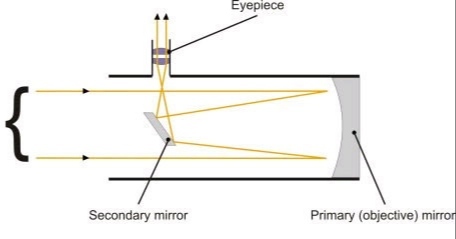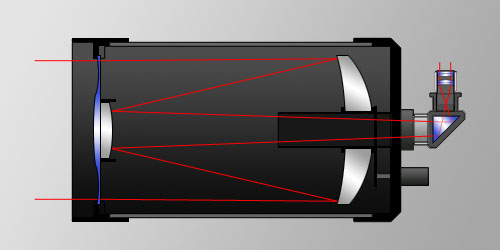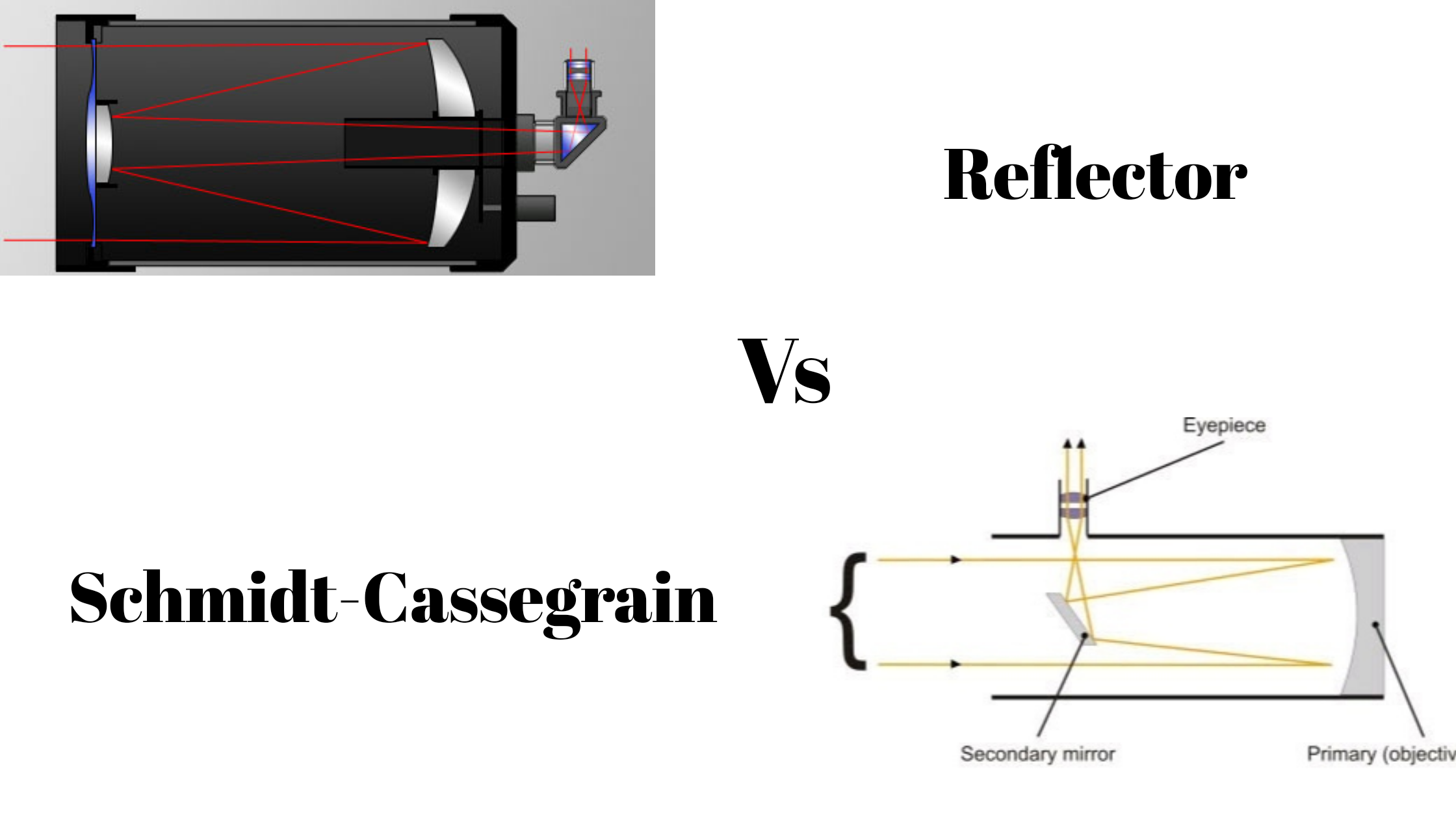*This post may contain affiliate links. This means we may make a commission if you purchase an item using one of our links*
As someone getting into telescopes, you’re bound to have come across a variety of different words attached to these devices, like apochromatic refractor, ritchey-chretien, maksutov-cassegrain, newtonian reflector and so on. In that sense I wouldn’t be surprised if you’re completely lost in regards to what device you should pick up right?
In this article, I’ll specifically be going over two of the more well know telescope optics, a Schmidt-Cassegrain telescope and a reflector device so at least by the end of this you’ll have a better idea about which optic suits you best.
Reflector telescopes are often found within far cheaper telescopes due to their cost efficiency and are, as the name would suggest, made out of reflective mirrors compromised of a primary and secondary mirror. Schmidt-Cassegrain (SCT) telescopes are often referred to as catadioptric/compound based optics as they utilise both glass and mirrors to produce their visuals. As a result they cost significantly more.
Both have their pros and cons, which is what I’ll be delving fare deeper into throughout the rest of this comparison.
How Does A Reflector Telescope Work?
Table of Contents

Reflector optics utilise mirrors to produce visuals for telescopes. These mirrors are as I mentioned earlier, regarded as primary and secondary mirrors. The primary is concave mirror whilst the secondary mirror is flat with its main purpose being to reflect the gathered light into an eyepiece and ultimately to your eyes.
As for how a reflector telescope works, light is often gathered in through the open end of the tube near the top of the device hitting the concave mirror at the base before reflecting onto the secondary mirror and then into your eye.
These devices can come in multiple different variations but the most common ones utilised are Newtonian reflector and spherical reflectors for the more affordable telescopes.
The main difference between a spherical and newtonian is that a newtonian reflector uses a parabolic primary mirror which allows for light to focus at a singular point unlike spherical reflectors that use a spherical primary mirror which produce blurry and unfocused visuals.
As a result Newtonian reflectors are definitely the superior reflective telescope. Reflective optics are known to be the best for viewing faint deep space objects and also produce more colour accuracy than glass based telescopes (aka refractors).
One of the negatives of these optics is that the OTA tube will be open meaning far more maintenance will be required to keep the visuals at a high level as the mirrors will get dusty and they’re also easier to knock out of alignment due to this design.
Nevertheless, reflectors provide the best aperture per dollar ratio in the market which is why they’re very popular among most amateur astronomers and veterans who want largest apertures for a relatively affordable price.
How Does A Schmidt-Cassegrain Telescope Work?

Schmidt-Cassegrain optics are a sub variation of the cassegrain optical variation and as I mentioned earlier are formed using a combination of mirrors and glass within the chassis.
SCT devices use the same 2 mirrors that are associated with reflectors but with a corrector plate used at the top of the scope to minimise the spherical aberration and the coma that the spherical primary mirror produces.
As for how the light is gathered by a SCT telescope, the light first passes through the aspherical glass corrector plate at the front of the tube before it hits the spherical, concave primary mirror. It then bounces of the smaller convex secondary mirror before finally projecting through the hole at the center of the primary mirror into your eye or through your eyepiece into your eye.
Unlike a reflector devices, SCT’s are designed in a manner where the gathered light covers the whole length of the tube twice resulting in some loss of detail but also providing a much higher focal length (which is further enhanced by the convex secondary mirror) making these optics well equipped for planetary observation.
As a result SCT’s are often far more compact than reflector telescopes and certainly more versatile as they’re not only good for deep sky viewing but great beginner level astrophotography optics too unlike, reflectors. These optics are also enclosed in a tube meaning far less maintenance is required for users as well.
Of course as a result of the versatility and compact design SCT’s do cost a lot more than a reflector telescope with the same aperture.
Similarities Between A Schmidt-Cassegrain And Reflector Telescope
The first similarity between both optical designs is that mirrors are a major part of how the optics works as both designs do use a primary concave and secondary mirror.
Both provide solid imagery from faint deep space objects and both are colour accurate too. In essence Schmidt-Cassegrain and reflectors do have similar quality visuals but, as mentioned earlier SCT’s are a little more versatile for the more intermediate level astronomers who want to do more than just looking through an eyepiece and observe stars and planets.
Differences Between A Schmidt-Cassegrain And Reflector Telescope
There are a whole variety of differences between these two optical variations which include the following :
- SCT’s produce much larger focal lengths over similar sized reflectors making them far better for planetary viewing
- SCT’s tend to be far smaller in frame over similar sized reflectors devices, whether a Dobsonian reflector or otherwise
- SCT’s use both mirrors and a glass lens within its chassis
- SCT’s are far more versatile in the sense they can be great for astrophotography and tend to work far better with GoTo mounts over reflectors
- Reflector telescope are the most cost effective optics for telescopes around
- Reflectors require much more maintenance over the enclosed tube SCT’s
- SCT’s can only be made for practical use upto 16″ (due to the difficulty of making the corrector plate) as opposed to reflectors that genuinely have no boundaries.
- Reflector’s will need to be collimated more due to the open tube design
- As the gathered light bounces twice in the tube it does decrease the max potential of a 6″ aperture SCT design over a reflector telescope at the same aperture.
Besides the corrector plate used, a schmidt device is essentially a spherical mirror based reflector so the colour quality and accuracy shouldn’t be too far from a reflector. Nevertheless, the two optical variations do have their differences, which is clearly illustrated by their designs and of course from the points mentioned above.
Summary
As a whole if you’re looking at an SCT device or vice versa as your first… 3rd telescope etc. as long as you do a bit of research to find out if it’s a device worth getting, you won’t be disappointed.
If you’re on a budget but want the best bang for your buck, a dobsonian Newtonian reflector is always a great way to go. On the other hand if you want a very versatile telescope that’s easy to store, can dabble in astrophotography and provides excellent visuals (for a steeper price) an SCT is also an excellent way to go.
Myself and many others would personally recommend investing in a Dobsonian reflector first due to their value but SCT’s with their lower maintenance might just sway you in that direction. In the end of the day the choice is yours to make.

